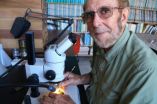(Press-News.org) MADISON, Wis. — The mechanical force that a single fungal cell or bacterial colony exerts on a plant cell may seem vanishingly small, but it plays a heavy role in setting up some of the most fundamental symbiotic relationships in biology. In fact, it may not be too much of a stretch to say that plants may have never moved onto land without the ability to respond to the touch of beneficial fungi, according to a new study led by Jean-Michel Ané, a professor of agronomy at the University of Wisconsin-Madison.
"Many people have studied how roots progress through the soil, when fairly strong stimuli are applied to the entire growing root," says Ané, who just published a review of touch in the interaction between plants and microbes in the journal Current Opinion in Plant Biology. "We are looking at much more localized, tiny stimuli on a single cell that is applied by microbes."
Specifically, Ané, Dhileepkumar Jayaraman, a postdoctoral researcher in agronomy, and Simon Gilroy, a professor of botany, studied how such a slight mechanical stimulus starts round one of a symbiotic relationship — that is, a win-win relationship between two organisms.
It's known that disease-causing fungi build a structure to break through the plant cell wall, "but there is growing evidence that fungi and also bacteria in symbiotic associations use a mechanical stimulation to indicate their presence," says Ané. "They are knocking on the door, but not breaking it down."
After the fungus announces its arrival, the plant builds a tube in which the fungus can grow. "There is clearly a mutual exchange of signals between the plant and the fungus," says Ané. "It's only when the path is completed that the fungus starts to penetrate."
Mycorrhizae are the beneficial fungi that help virtually all land plants absorb the essential nutrients — phosphorus and nitrogen — from the soil. Biologists believe this ubiquitous mechanism began about 450 million years ago, when plants first moved onto land.
Mechanical signaling is only part of the story — microbes and plants also communicate with chemicals, says Ané. "So this is comparable not to breaking the door or even just knocking on the door, but to knocking on the door while wearing cologne. Clearly the plant is much more active than we thought; it can process signals, prepare the path and accept the symbiont."
Beyond fungi, some plants engage in symbiosis with bacteria called rhizobia that "fix" nitrogen from the atmosphere, making it available to the plant.
Rhizobia enable legumes like soybeans and alfalfa to grow without nitrogen fertilizer.
When Ané and his colleagues looked closer, they found that rhizobium symbiosis also employs mechanical stimulation. When the bacterium first contacts a root hair, the hair curls around the bacterium, trapping it.
The phenomenon of curling has been known for almost 100 years. "But why would nature develop such a complicated mechanism to entrap a bacterial colony?" Ané asks. "We propose the purpose is to apply mechanical stimulation" so the plant will start building a home for the rhizobium — for mutual benefit. "We have preliminary evidence that when the entrapment is not complete, the process of colonization does not happen," he says.
Again, the two-step communication system is at work, Ané adds. "The curling process itself can only begin when the plant gets a chemical signal from the bacterium — but the growing tube inside the root hair that accepts the bacteria requires something else, and nobody knew what. We propose it's a mechanical stimulation created by entrapping, which gives the bacterial colony a way to push against the root."
In many respects, this symbiosis parallels the older one between plants and beneficial fungi, Ané says. Indeed, he says legumes have "hijacked" the mycorrhizae system. "Plants used the symbiosis toolkit to develop this relationship with mycorrhizae, and then used it again for bacteria. This dual requirement for chemical and mechanical signals is present in both associations, even though the association between rhizobia and legumes is only 60 million years old."
INFORMATION:
David Tenenbaum
608-265-8549
djtenenb@wisc.edu
A touching story: The ancient conversation between plants, fungi and bacteria
2014-08-27
ELSE PRESS RELEASES FROM THIS DATE:
Protein in 'good cholesterol' may be a key to treating pulmonary hypertension
2014-08-27
Oxidized lipids are known to play a key role in inflaming blood vessels and hardening arteries, which causes diseases like atherosclerosis. A new study at UCLA demonstrates that they may also contribute to pulmonary hypertension, a serious lung disease that narrows the small blood vessels in the lungs.
Using a rodent model, the researchers showed that a peptide mimicking part of the main protein in high-density lipoprotein (HDL), the so-called "good" cholesterol, may help reduce the production of oxidized lipids in pulmonary hypertension. They also found that reducing ...
Research geared to keep women from fleeing IT profession
2014-08-27
WACO, Texas (August 27, 2014) – For years, employers and experts have been trying to reverse the exodus of women from information technology positions.
They're failing.
Studies show that women are significantly underrepresented in the IT field, and the number of women who've graduated with degrees in computer and information science have plummeted from 37 percent in 1985 to 18 percent in 2011.
The failure to "stop the bleeding" stems, in part, from the industry's reliance on an oft-cited, outdated and under-studied research model, said Cindy Riemenschneider, Ph.D., ...
No cookie-cutter divorces, so what info should online co-parenting classes offer?
2014-08-27
URBANA, Ill. – Required online classes for divorcing couples who have children are good at teaching parents how to deal with children's needs and responses to their family's new situation. But co-parenting couples would benefit from content that helps adults cope with their own emotions and from unique tracks for families with special circumstances such as intimate partner violence or alcoholism, said a University of Illinois researcher in human and community development.
"There is no cookie-cutter divorcing couple, and with online programming, educators are able to supply ...
NASA telescopes uncover early construction of giant galaxy
2014-08-27
Astronomers have for the first time caught a glimpse of the earliest stages of massive galaxy construction. The building site, dubbed "Sparky," is a dense galactic core blazing with the light of millions of newborn stars that are forming at a ferocious rate.
The discovery was made possible through combined observations from NASA's Hubble and Spitzer space telescopes, the W.M. Keck Observatory in Mauna Kea, Hawaii, and the European Space Agency's Herschel space observatory, in which NASA plays an important role.
A fully developed elliptical galaxy is a gas-deficient ...
The high cost of hot flashes: Millions in lost wages preventable
2014-08-27
The steep decline in the use of hormone therapy has spawned a prevalent but preventable side effect: millions of women suffering in silence with hot flashes, according to a study by a Yale School of Medicine researcher and colleagues.
In the study published in the Aug. 27 online issue of the journal Menopause, the team found that moderate to severe hot flashes — also called vasomotor symptoms (VMS) — are not treated in most women. Women with VMS experience more than feeling hot; other frequently occurring symptoms include fatigue, sleep disturbance, depression, anxiety, ...
NASA begins hurricane mission with Global Hawk flight to Cristobal
2014-08-27
The first of two unmanned Global Hawk aircraft landed at NASA's Wallops Flight Facility in Wallops Island, Virginia, on Aug. 27 after surveying Hurricane Cristobal for the first science flight of NASA's latest hurricane airborne mission.
NASA's airborne Hurricane and Severe Storm Sentinel, or HS3, mission returns to NASA Wallops for the third year to investigate the processes that underlie hurricane formation and intensity change in the Atlantic Ocean basin. HS3 is a collaborative effort that brings together several NASA centers with federal and university partners.
The ...
Junk food makes rats lose appetite for balanced diet
2014-08-27
A diet of junk food not only makes rats fat, but also reduces their appetite for novel foods, a preference that normally drives them to seek a balanced diet, reports a study published in the open-access journal Frontiers in Psychology.
The study helps to explain how excessive consumption of junk food can change behavior, weaken self-control and lead to overeating and obesity.
The team of researchers, led by Professor Margaret Morris, Head of Pharmacology from the School of Medical Sciences, UNSW Australia, taught young male rats to associate each of two different sound ...
Nanodiamonds are forever
2014-08-27
Most of North America's megafauna — mastodons, short-faced bears, giant ground sloths, saber-toothed cats and American camels and horses — disappeared close to 13,000 years ago at the end of the Pleistocene period. The cause of this massive extinction has long been debated by scientists who, until recently, could only speculate as to why.
A group of scientists, including UC Santa Barbara's James Kennett, professor emeritus in the Department of Earth Science, posited that a comet collision with Earth played a major role in the extinction. Their hypothesis suggests that ...
IU study: Social class makes a difference in how children tackle classroom problems
2014-08-27
BLOOMINGTON, Ind. -- An Indiana University study has found that social class can account for differences in how parents coach their children to manage classroom challenges. Such differences can affect a child's education by reproducing inequalities in the classroom.
"Parents have different beliefs on how to deal with challenges in the classroom," said Jessica McCrory Calarco, assistant professor in IU Bloomington's Department of Sociology in the College of Arts and Sciences. "Middle-class parents tell their children to reach out to the teacher and ask questions. Working-class ...
Wolves susceptible to yawn contagion
2014-08-27
Wolves may be susceptible to yawn contagion, according to a study published August 27, 2014 in the open-access journal PLOS ONE by Teresa Romero from The University of Tokyo, Japan, and colleagues.
Researchers suggest that contagious yawning may be linked to human capacity for empathy, but little evidence apart from studies on primates, exists that links contagious yawning to empathy in other animals. Recently, researchers have documented domestic dogs demonstrating contagious yawning when exposed to human yawns in a scientific setting, but it is unclear whether this ...







